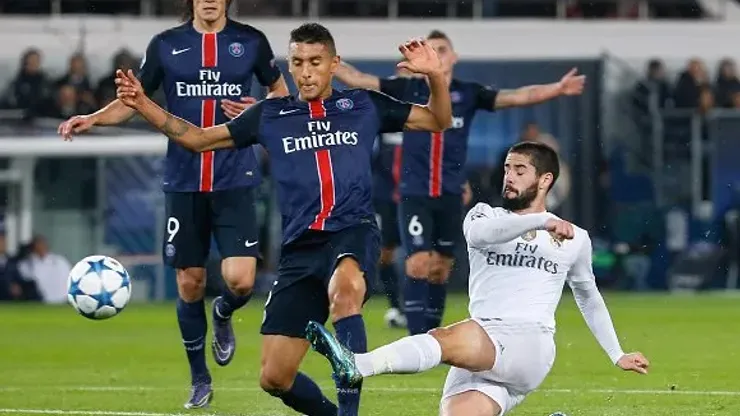In a game of one European titan and one team on its way toward the same stature, how was Real Madrid able to come away from the match with three points against Paris Saint-Germain?
In order to understand how Nacho netted the only goal of the match in the 35th minute, it is important to look back at two moments previous to the build-up of that play.
Though PSG was more dangerous through the first 20 or so minutes, in the 7th minute there was a moment where PSG revealed their defensive organization. Before either of the first Real or PSG early substitutions were made (which perhaps had some effect on the continuity or connectedness of PSG), we can see the defensive structure of a 4 – 4 – 1 – 1 that PSG wanted to create as Real Madrid passed half field and moved toward the attacking third.
Below, PSG had (although not pictured) four defenders, a block of four midfielders with one player looking to pressure the ball ahead of the midfield line and Zlatan Ibrahimovic staying high should PSG win the ball back.
In the 19th minute, Cristiano Ronaldo’s great off-ball movement completely disrupted PSG’s defensive shape. Rather than pressing higher and higher up the field, Ronaldo chose to withdraw into the midfield. This dragged PSG’s right back, Aurier, along with him into the midfield. By vacating the defensive third, the remaining three PSG defenders stayed compact and central, naturally leaving a huge amount of space on either side of them. What was, defensively speaking, PSG’s 4 – 4 – 1 – 1 became something of a 3 – 6 – 1 or 3 – 4 – 2 – 1. Should a ball into that space along the side of PSG’s temporary back three have been played by Real Madrid, either Aurier or Di Maria would have had to track back toward their own goal in an effort to prevent any further damage. However, in this instance PSG were unpunished and continued, in turn, trying to break down Real Madrid after winning the ball back.
Working the ball side to side, Real Madrid patiently started up another attack in the 35th minute as can been seen in the image below. Through this build up, Real Madrid were able to create an almost identical puzzle for PSG’s defense to try and solve with Ronaldo once again moved back into the midfield, which caused Aurier once more to follow him. This time however, Aurier perhaps even worried too much (though understandably) about Ronaldo, and left the PSG midfield scrambling to close down Kroos, who at that particular moment was in fact the most dangerous player as he was advancing toward goal with the ball.
Nacho, who had been substituted in for Marcelo, but much unlike Marcelo’s movement in 19th minute, elected to make a run into that very same space that had been created by Ronaldo’s movement just as Kroos took a shot at goal.
Rather than just stop running toward goal, Nacho continued his run in anticipation of the very opportunity that unfolded. Neither Di Maria nor Aurier properly recovered and Nacho was left all alone to try and put away the lone goal of the game after the Kroos shot deflected opportunistically off of Thiago Silva.
Sure. Maybe PSG’s keeper had a lapse in judgement when it came to his positioning on Nacho’s rebound. But Di Maria and Aurier really put him in a tough spot irrespective of Trapp’s decision making.
After the goal was scored, PSG was unable to get back in the game with several quality opportunities in the last ten minutes of the first half. However, the second half ultimately ended up with no additional goals and preserved the 1- 0 victory for Real Madrid.
200+ Channels With Sports & News
- Starting price: $33/mo. for fubo Latino Package
- Watch Premier League, Women’s World Cup, Euro 2024 & Gold Cup
The New Home of MLS
- Price: $14.99/mo. for MLS Season Pass
- Watch every MLS game including playoffs & Leagues Cup
Many Sports & ESPN Originals
- Price: $10.99/mo. (or get ESPN+, Hulu & Disney+ for $14.99/mo.)
- Features Bundesliga, LaLiga, Championship, & FA Cup
2,000+ soccer games per year
- Price: $5.99/mo
- Features Champions League, Serie A, Europa League & Brasileirāo
175 Premier League Games & PL TV
- Starting price: $5.99/mo. for Peacock Premium
- Watch 175 exclusive EPL games per season






